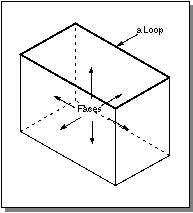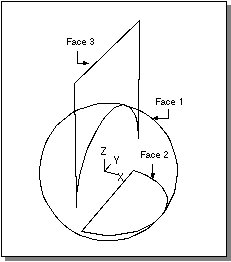|
A face is a portion of a single geometric surface in space--the two-dimensional analogue of the body.
|
|
|
Face Boundary Defined by Loops
|
|
|
Zero or more loops of edges constitute the boundary of a face. Figure 6-8 shows a loop of the top face (there are six faces) of a rectangular block.
|
|

|
|
|
Figure 6-8. Faces
|
|
|
Each loop determines a portion of the surface that is
inside the face and a portion that is
outside the face. If the face has no loops, the whole of the surface on which it lies is considered to be inside the face.
|
|
|
If the inside and outside of all the loops are consistent (any line in the surface that joins a point inside to one outside must cross at least one loop) and the inside is connected, then the face is
incompletely defined. A complete face whose inside is not bounded in space is said to be
infinite. It is normally not meaningful to ask whether an incomplete face is finite or infinite. There are severe restrictions in
ACIS on the operations that can be applied to infinite or incomplete faces.
|
|
|
Face Sidedness, Sense, and Containment
|
|
|
A face's
sidedness indicates whether it is single-sided or double-sided. A
single-sided face has material (a solid region) on one side (the "inside"), and is void on the other (the "outside"). A single-sided face either completely or partially bounds a solid region, and the face divides the inside from the outside. (A single-sided face is a solid body, not a sheet body.) A
double-sided face means that the points on either side are either
all inside or
all outside. If they are all outside, the face is considered to represent an idealized, infinitely thin sheet (a 2D region). If they are all inside, the face is an internal partition embedded in a solid.
|
|
|
The normal to a face can be either the same direction as the normal of the underlying surface at any position, or it can be the reverse of the surface normal. If it is the same as the surface normal, the face's
sense relative to the surface normal is
forward; otherwise, its sense is
reversed. A single-sided face's normal always points
away from the solid region (the material), regardless of the face's sense. Figure 6-9 shows a body with two single-sided faces bounding a solid region; the face normals point away from the material.
|
|

|
|
|
Figure 6-9. Single-Sided Face Normals
|
|
|
A double-sided face's
containment indicates whether or not the double-sided face is embedded within another region (i.e., contained). It indicates where the solid region (material) is. If a double-sided face is embedded in a solid region, its containment is
both-inside. If it is a 2D region, its containment is
both-outside. Containment is not applicable to single-sided faces, because they bound solid regions.
|
|
|
Unlike representations that use a lamina (two back-to-back faces) to represent sheets, 2D regions and embedded faces are stored as a single face representation in
ACIS. Faces that make up 2D regions and embedded surfaces are distinguished from faces that form the external boundary of a solid region by the face's sidedness, sense, and containment.
|
|
|
An
ACIS face meets one of the following combinations of sidedness, sense, and containment:
|
|
|
Single-sided, either sense
|
The face bounds a solid region (either completely or partially), so there is material on one side of the face and the other side is void. The "inside" of the face is solid and the "outside" of the face is void. The face normal points away from the material.
|
|
|
Double-sided, both-inside
|
The face is embedded in a solid. Both sides of the face are solid (there is material on both sides). The face normals point to the inside.
|
|
|
Double-sided, both outside
|
The face is a 2D region. Both sides of the face are void. Normals point outside.
|
|
|
The following methods (member functions) of the
FACE class are used to determine a face's sidedness, sense, and containment:
|
|
|
FACE::sides
|
Returns an indicator of the number of sides in the face, either
SINGLE_SIDED or
DOUBLE_SIDED.
|
|
|
FACE::sense
|
Returns an indicator of the face's sense relative to the underlying surface normal, either
FORWARD or
REVERSED.
|
|
|
FACE::cont
|
Returns an indicator of a double-sided face's containment, either
BOTH_OUTSIDE or
BOTH_INSIDE. This does not apply to single-sided faces.
|
|
|
Figure 6-10 shows an
ACIS model that contains three types of faces as defined by their combinations of sidedness, sense, and containment:
|
|

|
Face 1 is a spherical face that bounds a solid ball region; it is single-sided. The face normal points away from the sphere. The surface normal in this case also points away from the sphere, so the sense of the face is forward.
|

|
Face 2 is embedded in a solid sphere; it is double-sided, both-inside.
|

|
Face 3 is a 2D dangling flap; it is double-sided, both-outside.
|

|
|
Figure 6-10. Three Face Types
|
|
|
Single-Sided Face Bodies versus Sheet Bodies
|
|
|
A
single-sided face body is a solid body, not a sheet body. A
sheet body is an infinitely thin body.
ACIS considers a single-sided face body to be a solid that extends from the back side of the face out to infinity, with ill-defined boundaries extending where the edges of the original face extend backward. Because a single-sided face body is a solid, basic solid modeling concepts apply. Due to the ill-defined boundaries of a single-sided face body, subsequent solid modeling operations, such as Booleans, may not work, depending on how the single-sided face body is being used. When
ACIS makes a body from a face, such as with API
api_mk_by_faces, the body is a solid single-sided face, not a sheet body.
|